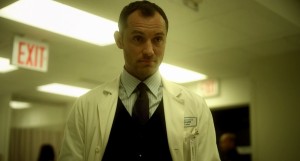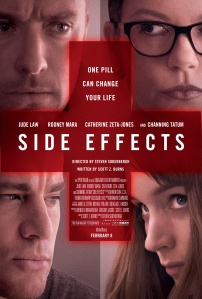Thirty minutes into Stephen Soderbergh’s Side Effects, I texted my sister that she really needed to see this movie. As she is studying to become a therapist, I thought she would find the film’s depiction of the fraught relationship between doctors and pharmaceutical companies interesting. Plus, there’s always Jude Law and Channing Tatum to look at.
By the final act, I had reversed my initial judgment.
 The first two thirds of Side Effects centers on Emily (Rooney Mara), the young wife of Martin Taylor (Channing Tatum) who has just been released from prison after serving time for insider trading. We learn that Emily had issues with depression in the past. Mara is effective in communicating Emily’s vulnerability. She seems haunted, like around every corner there is another unhappiness waiting for her. It comes as no surprise when she attempts suicide. She survives but is put under the care of Dr. Jonathan Banks (Jude Law).
The first two thirds of Side Effects centers on Emily (Rooney Mara), the young wife of Martin Taylor (Channing Tatum) who has just been released from prison after serving time for insider trading. We learn that Emily had issues with depression in the past. Mara is effective in communicating Emily’s vulnerability. She seems haunted, like around every corner there is another unhappiness waiting for her. It comes as no surprise when she attempts suicide. She survives but is put under the care of Dr. Jonathan Banks (Jude Law).
From the beginning, Banks seems too polished to be reliable. Jude Law is an attractive man, and here he utilizes those good looks (not to mention his clipped English accent) to paint a portrait of a man whose privileged lifestyle is dependent upon maintaining a good relationship with both his wealthy patients and the pharmaceutical companies. He supplements his income by cooperating in paid research studies. The reps give him the pills; he prescribes them to his patients and later reports back on the results.
At one point during Side Effects, a doctor says, “Patients ask for pills by name now. They hear about them from their friends, see the commercials on TV.” In other words, advertising has created a desire for a particular medication before a need has been diagnosed by a medical professional. And if that medical professional is part of a paid research study with the supplier of that drug, he or she has every reason to prescribe it. How on earth this remains legal, I don’t know.
 In Emily’s case, the (fictional) drug is Ablixa. For a while, it seems to work. She begins to take an interest in her life again, and her relationship with her husband is salvaged. Soon however she begins to sleepwalk. Her body moves, yet her mind is asleep. So Banks prescribes another drug, which seems to take care of that problem. Then someone turns up dead.
In Emily’s case, the (fictional) drug is Ablixa. For a while, it seems to work. She begins to take an interest in her life again, and her relationship with her husband is salvaged. Soon however she begins to sleepwalk. Her body moves, yet her mind is asleep. So Banks prescribes another drug, which seems to take care of that problem. Then someone turns up dead.
Of course, Emily is the prime suspect. But if she commits a crime under the influence of a drug her doctor was paid to prescribe for her, is she truly guilty? Ann Dowd (Complicity) as the mother of the victim has a wonderful moment in which she expresses both her grief at the crime and her belief that Emily, if she committed the crime, is not a murderer. I don’t think Dowd will every win an Academy Award–she is not Hollywood enough to gain that kind of recognition–but she is certainly one of the most gifted actors working today and deserves more mainstream attention.
SPOILERS SPOILERS SPOILERS
Up through the crime and its immediate aftermath, Side Effects is fascinating. But then it takes a left turn that completely undermines our understanding of the characters with whom we have spent the last two hours. It was at that moment it lost my attention.
Martin is killed. Emily is committed to a mental institution for his murder. The crime is depicted onscreen; she is shown as stabbing him to death while sleepwalking. The initial verdict is that she did kill him but had no idea what she was doing. Banks continues to treat her even as he comes under fire for prescribing the drug. Then he (and we) learn Emily had a relationship with Dr. Victoria Siebert (Catherine Zeta-Jones, looking as perfect as ever) while her husband was in jail. The two women plotted to murder Martin and run away together with his money. Siebert taught Emily how to “act” depressed. Emily provided access to financial materials. Banks was involved by coincidence; they had planned to use whatever doctor was on duty during Emily’s fake suicide attempt.
The difficulty with this kind of plot twist is that it is unsubstantiated by the rest of the film. We only meet Sieber once before the big revelation. By the time she shows up again forty minutes after she is introduced, I was wondering why they had hired an A-lister like Zeta-Jones to play a role that could have easily been filled by someone cheaper. While the last minute revelation that Siebert is the bad guy explains that particular casting decision, it doesn’t make the sudden twist any more satisfying.
For comparison, consider the final scene of The Sting (1973). In that film, two hustlers (Robert Redford and Paul Newman) are trying to con the villain (Robert Shaw) out of money he won on a horse race. Over the course of the story, Robert Redford’s character is established as being a young hothead who is desperate for money. So when Redford and Newman get in a dramatic shootout in the final moments of the film over Redford betraying the sting to Shaw, it makes sense in the world of the film. Shaw runs for the hills so as not to be implicated in a double homicide, and all seems lost. Then both “victims” sit up, wipe the fake blood from their lips and smile at each other. The shootout had been the final act of the con.
This plot twist works because prior events have established that EITHER Redford would turn traitor to keep the money for himself OR the shootout was a fake. Both outcomes are possible, so it is a wonderful surprise when the film seems to take us down one road only to reveal that all is not as it seems. The trick on the audience in The Sting plays by the rules, which is why that movie is held up as a example of great storytelling and Side Effects is not.
 On another, more uncomfortable note, the sexual relationship between Siebert and Emily is handled like a schoolboy’s fantasy. I won’t demean same-sex relationships by calling this a lesbian relationship. No, it’s a fetish relationship– two women, doctor and patient, manipulator and manipulatee, whatever. Say it with me, Hollywood: some women happen to be lesbians. In general, they look like everyone else. I won’t say that “sexy” lesbian scenes have to go away (because beautiful people screwing is a mainstay of popular entertainment), but this tendency to depict women as only engaging in same-sex relationships when there aren’t any men around or because they are manipulative bitches certainly needs to vanish.
On another, more uncomfortable note, the sexual relationship between Siebert and Emily is handled like a schoolboy’s fantasy. I won’t demean same-sex relationships by calling this a lesbian relationship. No, it’s a fetish relationship– two women, doctor and patient, manipulator and manipulatee, whatever. Say it with me, Hollywood: some women happen to be lesbians. In general, they look like everyone else. I won’t say that “sexy” lesbian scenes have to go away (because beautiful people screwing is a mainstay of popular entertainment), but this tendency to depict women as only engaging in same-sex relationships when there aren’t any men around or because they are manipulative bitches certainly needs to vanish.
2 Stars
(I own nothing related to Side Effects or The Sting.)



